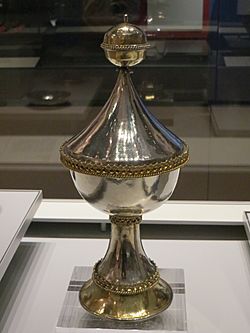Lacock Cup facts for kids
Quick facts for kids Lacock Cup |
|
|---|---|

Lacock Cup as displayed in the British Museum
|
|
| Material | Silver |
| Size | 33cm high |
| Created | Mid-Fifteenth Century |
| Present location | British Museum, London |
The Lacock Cup is a special silver cup from the late Middle Ages. It was first made for everyday use, which is quite rare. Most cups like it were changed or destroyed over time. However, this cup was given to St Cyriac's Church in Lacock, Wiltshire, England. The church used it as a chalice, which is a cup for religious ceremonies. Today, the Lacock Cup is kept at the British Museum in London. You can usually see it on display there.
What Makes the Lacock Cup Special?
The Lacock Cup was made in the mid-1400s. Experts say it is "one of the most important pieces of old English silver." Most fancy cups from that time were either lost or changed. This was because people's styles and tastes changed. But the Lacock Cup was given to the church very early on. This helped it stay in its original shape for hundreds of years.
After the English Reformation, religious practices changed. Churches needed bigger cups for communion wine. Also, strict rules were made against using religious images. The Lacock Cup was perfect for this new use. It has been on display at the British Museum since 1962.
Why the Cup Was Sold
In 2009, St Cyriac's Church needed money. They had many costs to fix and care for the church building. The church council decided to find out how much the cup was worth. Experts believed it was worth about £1.8 million.
The church council then asked for permission to sell the cup. The British Museum was very interested in buying it. They had been borrowing the cup for display. A local person tried to stop the sale. But in December 2013, a court decided the sale was fair.
Who Owns the Cup Now?
On December 24, 2013, the Lacock Cup was officially sold. The British Museum and the Wiltshire Museum in Devizes bought it together. They paid £1.3 million for the cup. This money came from private donations and special grants. These grants were from the National Heritage Memorial Fund and The Art Fund.
As part of the sale, two copies of the cup were made. One copy is used by the church for religious services. The other copy is shown at the Wiltshire Museum. This way, people can still see a version of the cup even when the original is not there.

